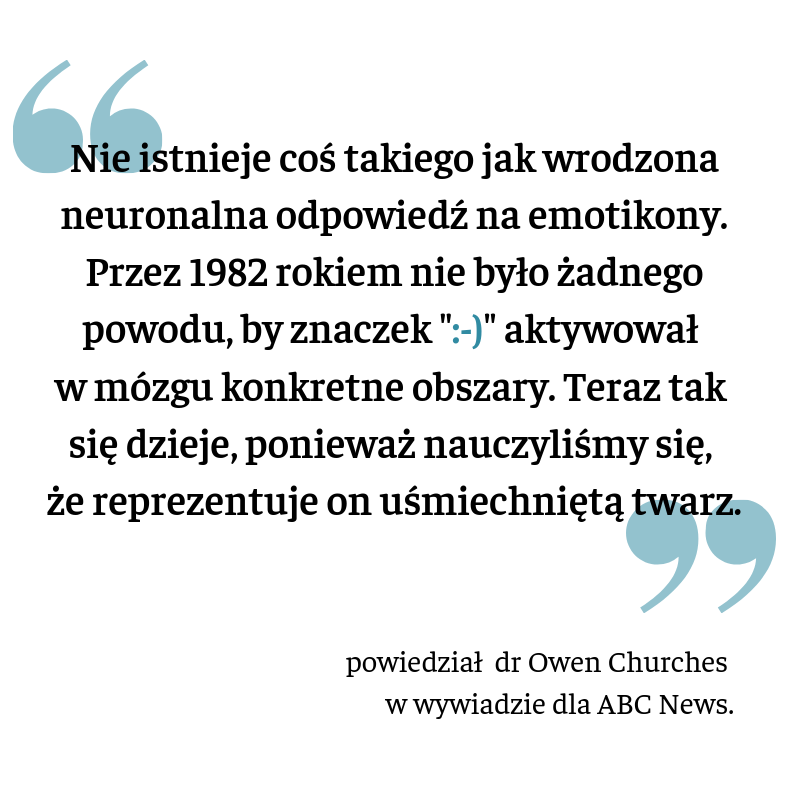Do you think that using emojis is only for millennials, and you use an exclamation point or caps lock to express emotions? Catch up quickly, because as Dr. Owen Churches argues, the stamp activates the same areas in the brain as a real smile.
Smiling people evoke positive emotions in us and give the impression of being trustworthy. Film? Imagine if it worked the same way in cyberspace. Cyber psychology researchers have noticed that our brains are so used to using emojis that they perceive them as real faces. Emojis are a new language, and in order to understand it, we have created new patterns of activity in the brain.
 Emojis help us communicate feelings that are often difficult for us to verbalize. They deepen the bond and arouse sympathy exactly as in real relationships. Without them, our virtual friendships would be devoid of feelings, our jokes would be incomprehensible, and our irony would go unnoticed.
Emojis help us communicate feelings that are often difficult for us to verbalize. They deepen the bond and arouse sympathy exactly as in real relationships. Without them, our virtual friendships would be devoid of feelings, our jokes would be incomprehensible, and our irony would go unnoticed.
However, pictograms are useful not only in private relationships, but also in marketing. Investigator’s team Simo Tchokini from Cambridge tracked half a million Facebook accounts and confirmed that users who use emojis frequently are more popular, get more likes, shares, and comments. Emojis can improve customer communication just as much as facial expressions or the right tone of voice in the real world. They are used not only in social media, but also in TV commercials for big companies like McDonalds.
Emojis aren’t just “fun.” Simple emojis can help clarify context and better understand or reinforce subtext. Their benefits go beyond improving our daily text messages and emails. Jenna Schilstra , a marketing analyst and passionate advocate of emojis, shows how pictograms can be used in completely new ways, such as in the therapy of abused children – emojis help them describe complex, difficult emotions – or in the processes of communication with people and people on the autism spectrum. For them, a pictogram is a very helpful communication tool. Eventually, Schilstra says, these new “signs” can make the phrase itself more accessible.
So don’t run away from emojis – smile back! 🙂
For those interested:
The expression of emotions in a written text has been thought about for a long time and has been tried in many different ways. The first fully confirmed attempt to introduce emoticons was an article published in 1881 in PUCK magazine. Their typographical proposals, however, were too complex for their use to become widespread.
![]()
The characteristic ” :-)” was first used in 1982 by an American scientist, Scott Fahlman, in response to a rather infantile joke of his colleagues. Normally serious, well-behaved gentlemen in white coats decided to spread a rumor that someone had inadvertently spilled poisonous mercury in one of the elevators of Carnegie Mellon University. Terrified workers avoided the deadly metal cage and were forced to run up the stairs of the multi-story building.
Fahlam appreciated the cabaret artistry of his colleagues, but at the same time appealed to ensure that in the future it would be easier to distinguish a joke from facts. If such jokes became commonplace, over time the information about the real threat would not be taken seriously either. So the professor sent a revolutionary message to the rest of the University’s employees, as it turned out later – with a request to mark jokes with the symbol “:-)”, and really sad messages with “:-(“
Regular emoticons depict ideograms of the human face, made up of characters available on the keyboard and rotated by 90 degrees. Here are the most commonly used emojis:
🙂 🙂 =) :3 – satisfaction, smile
:)) :-)) – joy, big smile, giggle
😀 😀 xD =D – happiness, very wide smile, laughter
😉 😉 – winking, winking
:’) :’-) – crying with happiness
🙁 🙁 =( – sadness, despondency
:(( :-(( – a lot of sadness, a lot of depression, (slight) crying
:C :-C =C xC 8C – very much sadness, very high depression
:'( :’-( – crying
😐 😐 – lack of emotion
:/ :-/ – skepticism, irritation, confusion, indecision
>>:) 🙂 – contentment (due to harm, pain, etc.), satanic smile
>:)) :-)) >- joy (because of harm, pain, etc.), satanic giggle
>>:D 😀 >xD – happiness (due to harm, pain, etc.), satanic laughter
>>:( 🙁 >x( – anger
😛 😛 xP :p :-p xp – ignoring, frustrating, showing your tongue
:O :-O 😮 😮 – surprise, fear, shock, surprise
:# 😡 – locking your mouth (“padlock”), “I won’t say anything”
|-) I-) |-O I-O – sleeping, falling asleep, yawning
There are also manga emojis derived from manga. These do not have to be turned to read the “expressions of their faces”, but in Europe they are less frequently used, and some are not understandable to us.
(n_n) (n.n) – contentment, smile
(••) (•^.^•^_^) (^.^) ^^ XoX – ea, big smile (^_^)
{-_-) {-.-) – secretive smile, tired, sleepy, sick
(^o^) (^O^) – joy, laughter
(*^o^*) (*^O^*) – happiness, excitement, big laughter
(u_u) (u.u) – sadness, sleeping
(O_O) (o_o) (o.o) (O.O) – astonishment, shock, surprise
(^_^;)– – laughing to hide your nerves
(^_~) (^_-) (^.~) (^.-) – winking, winking
(;_;) (;.;) ;; -crying
(>_<) (>.<) -anger
(∨_∨) (∨.∨) – lack of expression
(?_?) (?.?) – surprise, astonishment, confusion.
Have a nice day!:)
behind:
https://tech.wp.pl/jak-powstaly-emotikony-6034874669716609a
https://grafmag.pl/artykuly/od-emotikon-do-emoji-historia-i-wykorzystanie-w-reklamie
https://gazetalubuska.pl/emotikony-maja-ponad-35-lat-czym-sa-jak-powstaly-co-oznaczaja-lista-emotikonow-najczesciej-uzywanych-i-mangowych-emotikony-na/ar/13345084




